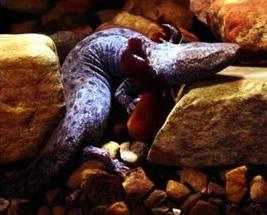
This amphibian is also called Escuerzo or Wide-mouth frog, an endangered species of frog due to habitat loss. It is
native to Argentina, Paraguay and Bolivia and lives on dry savanna, dry shrub land, freshwater marshes and ponds.
Budgett's frogs are very rare to find in a traditional chain pet shop. Due to their comical appearance, they are attractive
to amphibian keepers. This frog is aggressive and has been known to bite when cornered by a human or predator
2. Mexican Burrowing Toad (Rhinophrynus dorsalis)

Distinct among the frogs, the Mexican Burrowing Toad's tongue is projected directly out the front of the mouth, instead
of being flipped out, as in all other frogs. It is the only species with over 190 million years of independent evolution and
is the most evolutionarily distinct amphibian species on Earth today; a fruit bat, polar bear, killer whale, kangaroo and
human are all more similar to one another than this species is to any other amphibian. This frog lives from the southern
Texas through Mexico, Guatemala, Honduras, El Salvador to Nicaragua and Costa Rica.
3. Barred Tiger Salamander (Ambystoma mavortium)

This unique-looking creature named Barred Tiger Salamander is the State Amphibian of Kansas, USA. It is a species
of salamander found from southwestern Canada in British Columbia, Alberta, Saskatchewan and Manitoba, south
through the western US to Texas, and northern Mexico. It is a species with a broad head and a bulky body. Its skin is
moist and capable of growing to 14 inches or 35 cm in length.
4. Purple Frog (Nasikabatrachus sahyadrensis)

This is one of the freakiest looking creatures on Earth - the Purple Frog. It is also known as Pignose Frog and is
native to Western Ghats in India. The frog's reclusive lifestyle is what caused the species to escape earlier notice
by biologists. It was discovered only in 2003. This frog's cry sounds more like one from a chicken. The frog spends
most of the year underground, surfacing only for about two weeks, during the monsoon, for purposes of mating.
5. Common Mudpuppy (Necturus maculosus)

This weird-looking amphibian is endemic to northeastern US and parts of Canada. Mudpuppies prefer shallow
water with many places to hide, but have been found at depths of up to 90 feet and may live for up to 20 years. This
creature is nocturnal but can be active in the day in muddy or weed-choked waters. A carnivorous, it feeds on fish,
fish eggs, crayfish, insects, and mollusk.

6. Axolotl (Ambystoma mexicanum)

Axolotls fail to undergo metamorphosis and remain aquatic and gilled through adulthood. This unusual species
originates from Mexico. It also has the ability to regenerate most body parts. They are commonly kept as pets in the
US, UK, Australia, Japan and other countries.

Axolotl is one of the most popular weird amphibians in the world. This distinct creature should not be confused with
waterdogs and mudpuppies fully-aquatic salamanders which are not closely related to the axolotl but bear a superficial
resemblance.
7. Neuse River waterdog (Necturus lewisi)

The Neuse River Waterdog is found in rivers of North Carolina. It is a medium-sized Necterus with a rusty brown
dorsal side with many large, bluish black spots. The ventral side is dark brown to grey and also spotted. Males and
females are of a similar size and grow to a length of 16.5-28 cm from the tip of snout to tip of tail.
8. Suriname Horned Frog (Ceratophrys cornuta)

This odd-looking creature with exceptionally wide mouth known as Ceratophrys cornuta is also called as Amazonian
horned frog. This bulky frog may grow to a length of up to 20 cm. It is found in the northern part of South America. It has
horn-like projections above its eyes. Tadpoles of the Surinam horned frog attack each other (and tadpoles from other
species) soon after being hatched.

9. Olm (Proteus anguinus)

This blind animal native to southern Europe is also called Proteus. It lives in the waters that flow underground through
this extensive limestone region. It is the only European exclusively cave-dwelling chordate. It is also occasionally called
the "human fish" by locals because of its skin color, similar to that of Caucasians. This animal is most notable for its
adaptations to a life of complete darkness in its underground habitat. Although it is blind, its sense of smell and hearing,
are acutely developed. It also lacks any skin pigmentation. In contrast to most amphibians, the Olm is entirely aquatic,
and it eats, sleeps, and breeds underwater.
10. Texas Blind Salamander (Eurycea rathbuni)

Blind creature like the Texas Blind Salamander is a rare cave-dwelling amphibian. It is endemic to Texas. This animal
has blood-red external gills for absorbing oxygen from the water and grows to a length of 13 cm or 5 in. Its diet include
blind shrimp, snails, and amphipods
11. Albino Pacman Frog (Ceratophrys ornata)

This freaky frog is also known as Albino Argentine Horned Frog or Argentine Wide-mouthed Frog. It inhabits the rain
forests of Argentina, Uruguay and Brazil. A voracious eater, it will attempt to swallow anything that moves close to its
wide mouth, such as insects, small birds and mammals, lizards and other frogs, even if it would suffocate in the process.
Except for the Texas Blind salamander and Olm, most of these amphibians are good pets.
Hope you enjoyed this. Than you!























